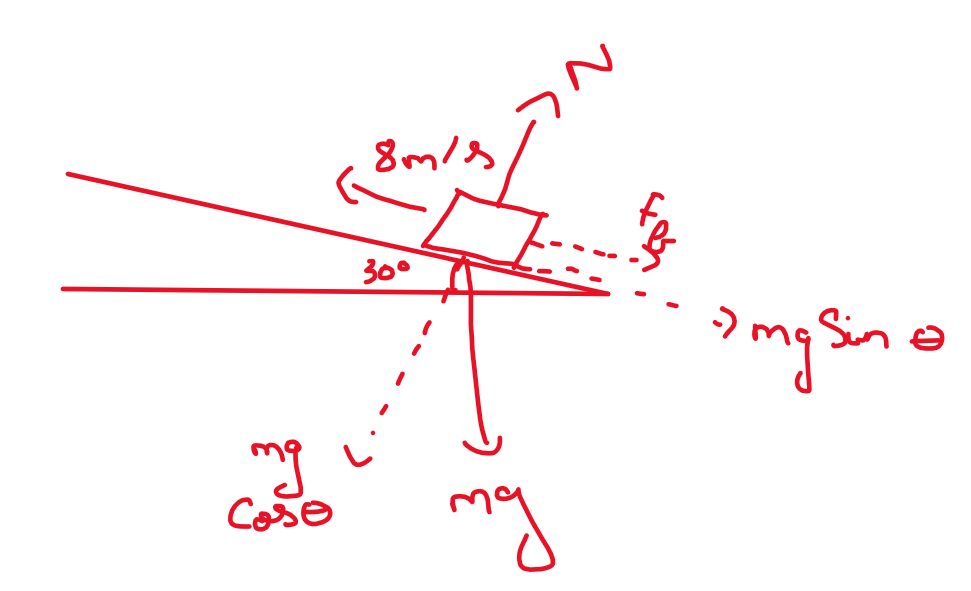A block is set into motion up an inclined plane (30° ) with an initial speed of 8.0 m/s. There is friction between the block ant the plane. The block comes to rest after traveling 4.8 m along the plane. V = 8 m/s What is the value of the coefficient of friction µ? HINT: remember that the friction force is given by f = µN = µ = Ń thus because both f and the N are proportional to the mass of the block m, m cancels out and you don't need it to find u. Thus you wont be able to find a value for f or N alone, so find your acceleration first, then an equation for u that is independent of m.
A block is set into motion up an inclined plane (30° ) with an initial speed of 8.0 m/s. There is friction between the block ant the plane. The block comes to rest after traveling 4.8 m along the plane. V = 8 m/s What is the value of the coefficient of friction µ? HINT: remember that the friction force is given by f = µN = µ = Ń thus because both f and the N are proportional to the mass of the block m, m cancels out and you don't need it to find u. Thus you wont be able to find a value for f or N alone, so find your acceleration first, then an equation for u that is independent of m.
College Physics
11th Edition
ISBN:9781305952300
Author:Raymond A. Serway, Chris Vuille
Publisher:Raymond A. Serway, Chris Vuille
Chapter1: Units, Trigonometry. And Vectors
Section: Chapter Questions
Problem 1CQ: Estimate the order of magnitude of the length, in meters, of each of the following; (a) a mouse, (b)...
Related questions
Question
Please note we can only enter numerical values in the answer box. Thank you

Transcribed Image Text:A block is set into motion up an inclined plane (30° ) with an initial speed of 8.0 m/s. There is
friction between the block ant the plane. The block comes to rest after traveling 4.8 m along
the plane.
V =8 m/s
What is the value of the coefficient of friction u?
HINT: remember that the friction force is given by
f = µN = µ =
N
thus because both f and the N are proportional to the mass of the block m, m cancels out and
you don't need it to find u. Thus you wont be able to find a value for f or N alone, so find your
acceleration first, then an equation for u that is independent of m.
Expert Solution
Step 1
The free body diagram for this problem is shown below

Step by step
Solved in 5 steps with 1 images

Recommended textbooks for you

College Physics
Physics
ISBN:
9781305952300
Author:
Raymond A. Serway, Chris Vuille
Publisher:
Cengage Learning

University Physics (14th Edition)
Physics
ISBN:
9780133969290
Author:
Hugh D. Young, Roger A. Freedman
Publisher:
PEARSON

Introduction To Quantum Mechanics
Physics
ISBN:
9781107189638
Author:
Griffiths, David J., Schroeter, Darrell F.
Publisher:
Cambridge University Press

College Physics
Physics
ISBN:
9781305952300
Author:
Raymond A. Serway, Chris Vuille
Publisher:
Cengage Learning

University Physics (14th Edition)
Physics
ISBN:
9780133969290
Author:
Hugh D. Young, Roger A. Freedman
Publisher:
PEARSON

Introduction To Quantum Mechanics
Physics
ISBN:
9781107189638
Author:
Griffiths, David J., Schroeter, Darrell F.
Publisher:
Cambridge University Press

Physics for Scientists and Engineers
Physics
ISBN:
9781337553278
Author:
Raymond A. Serway, John W. Jewett
Publisher:
Cengage Learning

Lecture- Tutorials for Introductory Astronomy
Physics
ISBN:
9780321820464
Author:
Edward E. Prather, Tim P. Slater, Jeff P. Adams, Gina Brissenden
Publisher:
Addison-Wesley

College Physics: A Strategic Approach (4th Editio…
Physics
ISBN:
9780134609034
Author:
Randall D. Knight (Professor Emeritus), Brian Jones, Stuart Field
Publisher:
PEARSON